Global Health 2035 is a global vision, but it will ultimately be realized at the national level — through programs and policies implemented in low- and middle-income countries.
The Global Health 2035 report makes a powerful health and economic case to health and finance ministers for increasing their domestic health investments, and outlines an investment framework for meeting the convergence goals within a generation. Global Health 2035 estimated that closing the health equity gap would cost an additional $70 billion/year from 2016 to 2035. This cost includes annual incremental investments of $33 billion/year for programmatic investments, $30 billion/year for health systems strengthening, and $7 billion/year for scaling up new health tools that are likely to be developed over the next 20 years.
One of the most important findings of the report—and one that has stimulated far-reaching policy discussion and debate—is that most of this incremental investment could come from domestic spending by low and middle income countries, provided that these countries begin actively planning to allocate a proportion of their economic growth over the next 20 years towards the health sector. Projected economic growth in the coming 20 years will allow countries to finance convergence primarily from domestic sources. Other sources of domestic financing—such as taxation of tobacco and removal of fossil fuel subsidies—can raise significant health revenue while helping countries achieve health gains.
Country engagements
We are working with governments and researchers in low- and middle-income countries, including India, Mexico, Ethiopia, Myanmar, and Ghana to help inform decision-making on national health investments. We are providing demand-driven technical support to countries to review their health financing portfolios, identify the most cost-effective health interventions, and examine ways to increase domestic health financing to fund scale up of these interventions.
Learn more about this work:
- India's domestic health investments
- Mexico: Convergence with the global best performers
- Ethiopia's domestic health investments
- Myanmar’s domestic health investments
- Ghana’s domestic health investments
Universal health coverage (UHC) implementation
Access to essential, life-saving health interventions can be enhanced — and progress towards the vision of Global Health 2035 can be accelerated — through universal health coverage (UHC).
The Global Health 2035 report recommends that national governments take one of two progressive pathways toward UHC which commit to covering the poor from the outset. In the first, publicly financed insurance would over essential health-care interventions to achieve convergence and tackle NCDs and injuries. This pathway would directly benefit the poor, since they are disproportionately affected by these problems. The second pathway provides a larger benefit package, funded through a range of financing mechanisms (e.g. payroll taxes, insurance premiums, copayments), with poor people exempted from all payments. Read more about the report’s key findings on UHC.
We are supporting ministries of health as they implement UHC by providing additional analytical and technical information about pathways to pro-poor UHC implementation.
For questions on the CIH Secretariat's work on domestic health investments and universal health coverage (UHC), please contact: Naomi Beyeler, Policy Program Manager.
